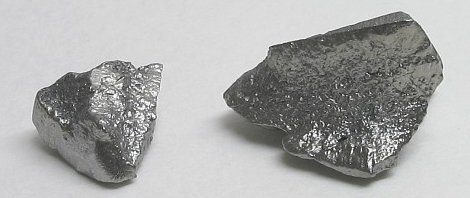Lutetium
Lutetium:

Picture of two small chunks of lutetium metal
Facts about Lutetium:
- Lutetium: Silvery white metal at standard conditions
- Fun fact about Lutetium: A Lutetium isotope (Lu 177) is used in certain therapies to treat some cancers. The FDA has approved the use because of its lower energy beta-emitting radionuclide.
- Chemical symbol: Lu
- Atomic number: 71
A crystal structure containing Lutetium:

Crystal structure used for Ni-Lu bonding interactions with Lu displayed in the centre of the structure.
Facts about this structure:
- Formula: C39 H63 Lu N3 P3
- Structure name: tris(N-{[bis(propan-2-yl)phosphanyl]methyl}anilinato)-lutetium(iii)
- Fun fact about the structure: This structure has the possibility to influence the catalytic activity of an active Nickel metal center by altering its coordination sphere.
- CSD refcode: TOCDIB (What’s this?)
- Associated publication: Bianca L. Ramirez, Prachi Sharma, Reed J. Eisenhart, Laura Gagliardi, Connie C. Lu, Chemical Science, 2019, 10, 3375, DOI: 10.1039/C8SC04712J
More about Lutentium:
Lutentium (Lu) is found in the earths crusts with other rare earth metals. It is the last element in the Lanthanides row of the periodic table (Z=71), it typically exists in the 3+ oxidation state. Lu was first found as a impurity on the element Yttrium (Z=70). Lu is the smallest of all Lanthanides and the highest; density, melting point (1652 C), and hardness. Besides some cancer therapies, Lutentium’s uses include Petroleum cracking in oil refineries. Pure Lutetrium is very expensive, even with price varying from different sources.
Learn More About the International Year of the Periodic Table (IYPT) in Crystals Project:
This project (#IYPTCrystals) is part of the International Year of the Periodic Table celebration (#IYPT2019), read more about the project here.
You can follow us on social media; search for #IYPTCrystals or follow The CCDC on X @ccdc_cambridge on Facebook ccdc.cambridge, on Instagram ccdc_cambridge or on YouTube CCDCCambridge.
Understand some of the terms and concepts used with our Frequently Asked Questions page here.
A 3D visualization showing Lutetium in real crystal structures: